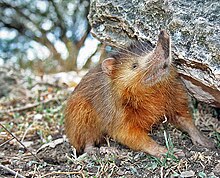| Hispaniolan solenodon[1] | |
|---|---|

| |
| Scientific classification | |
| Domain: | Eukaryota |
| Kingdom: | Animalia |
| Phylum: | Chordata |
| Class: | Mammalia |
| Order: | Eulipotyphla |
| Family: | Solenodontidae |
| Genus: | Solenodon |
| Species: | S. paradoxus
|
| Binomial name | |
| Solenodon paradoxus Brandt, 1833
| |

| |
| Hispaniolan solenodon range (brown) | |
| Synonyms | |
|
Solenodon woodi[3] | |
The Hispaniolan solenodon (Solenodon paradoxus), also known as the agouta,[4] is a small, furry, shrew-like mammal endemic to the Caribbean island of Hispaniola (in the Dominican Republic and Haiti). Like other solenodons, it is a venomous, insect-eating animal that lives in burrows and is active at night. It is an elusive animal and was only first described in 1833; its numbers are stable in protected forests but it remains the focus of conservation efforts.
Its smaller sister species of the same genus, Marcano's solenodon (S. marconoi) became extinct after European colonization. The Hispaniolan solenodon and the rat-like Hispaniolan hutia live in the same habitats and are the only surviving mammals native to the island.
- ^ Hutterer, R. (2005). "Order Soricomorpha". In Wilson, D.E.; Reeder, D.M (eds.). Mammal Species of the World: A Taxonomic and Geographic Reference (3rd ed.). Johns Hopkins University Press. p. 223. ISBN 978-0-8018-8221-0. OCLC 62265494.
- ^ Kennerley, R.; Turvey, S.T.; Young, R. (2020). "Solenodon paradoxus". IUCN Red List of Threatened Species. 2020: e.T20321A22327218. doi:10.2305/IUCN.UK.2020-3.RLTS.T20321A22327218.en. Retrieved 19 November 2021.
- ^ "Solenodon paradoxus (ASM Mammal Diversity Database #1003840)". Mammal Diversity Database. 2024. Retrieved 22 November 2024.
- ^ "Agouta". Collins Dictionary.
